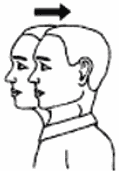Posture Exercises: Stretching & Exercising To Reduce Postural Neck Strain
Poor neck posture increases strain of the muscles, ligaments and joints and is related to pain and health disorders including temporomandibular, or TMJ (jaw), symptoms. Posture exercises can help.
When the head is positioned forward in relation to the upper body, the upper trapezius muscle’s electromyographic, or EMG, activity is significantly higher than it is when the head is in normal alignment. This can often result in a chronic condition called trapezius myalgia. The greater the EMG activity, the more likely you are to suffer from strain, spasm and pain from overusing the muscles.
In order to reduce neck pain and restricted movement from poor posture, exercises are performed repetitively within the pain-free range to stretch structures that poor posture tends to shorten, strengthen structures that poor posture tends to weaken and create an awareness of the desirable posture. Maintaining a better posture is thought to prevent positions that cause undue stress, microtrauma and overuse of stabilizing structures of the head and neck.
Stretching should be done in a slow, gradual, easy and painless manner. Move to the point of mild tension and Hold. Do not bounce.
| #1 – Chin Tucks Perform: Ten times on the hour Hold: Five seconds |
 |
| Tuck your chin back over the notch above your sternum, so that your ear is in line with the tip of your shoulder. For more details regarding this, please see neck exercises |
| #2 – Chest Stretch Perform: Three times a day, two repetitions Hold: 15 seconds |
 |
| Stand in a doorway or corner of a room. Lean forward, with your hands on the wall, until you feel significant stretching across the front of your chest. Do this exercise as requested in both positions. |
| #3 – Wall Stretch Perform: Three times a day, two repetitions Hold: 15 seconds |
 |
| Stand with your back against the wall and your arms positioned as shown in the drawing. Straighten your upper back and flatten your lower back against the wall. Press your head back with your chin down and inward, and pull your elbows back against the wall. Do this exercise as requested in both positions. |
| #4 – On Your Back Chest Stretch Perform: Before you retire, 10 repetitions |
 |
| Lie on your back with your hands clasped behind your head. As you exhale, slowly bring your elbows together, touching in front of your face. As you inhale, slowly draw the elbows apart until they touch the floor. |
| #5 – Face Down Arm Lifts Perform: once a day, five days a week |
 |
| Lie on your stomach as shown in the drawings (position 1 has the elbows at shoulder level and bent at 90 degrees, while position 2 has the elbows at ear level). Lift your arms, head and chest off the floor and repeat until you move only 50 percent through the range or until you are fatigued; do this in both positions. |
By incorporating at least one of these posture exercises into your daily routine, it can make a real difference.

